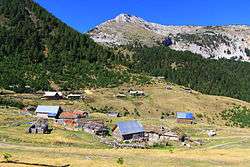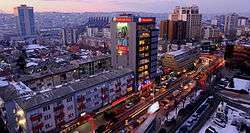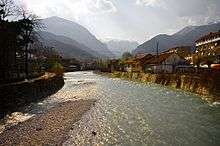Deçan
| Deçan | |
|---|---|
| Municipality | |
| Deçan / Deçani Dečani / Дечани | |
 Deçan Location in the Republic of Kosovo | |
| Coordinates: 42°32′N 20°17′E / 42.533°N 20.283°ECoordinates: 42°32′N 20°17′E / 42.533°N 20.283°E | |
| Country | Kosovo |
| District | District of Gjakova |
| Municipalities | Deçan |
| Government | |
| • Mayor | Rasim Selmanaj |
| Area | |
| • Total | 297 km2 (115 sq mi) |
| Elevation | 550 m (1,800 ft) |
| Population (2014) | |
| • Total | 40,847 |
| • Density | 140/km2 (360/sq mi) |
| Time zone | CET (UTC+1) |
| • Summer (DST) | CEST (UTC+2) |
| Postal code | 51000 |
| Area code(s) | 0381 390 |
| Car plates | 03 |
| Website | Municipality of Deçan |
Deçan or Dečani (Albanian: Deçan, Deçani; Serbian: Дечани, Dečani, pronounced [dɛ̌t͡ʃani]) is a town and municipality in the Gjakova district of western Kosovo. It is a mountainous area which borders Montenegro and Albania. There is a total of 36 villages within the municipality. The territory of the municipality is 371 km2.
During the 1998–1999 war, Deçan was one of the strongholds of the Kosovo Liberation Army (KLA) and subsequently suffered a large amount of infrastructure destruction by the Serbian military and paramilitary forces. Much reconstruction has taken place with the assistance of the international agencies and support from the Kosovo Albanian diaspora. It is widely known amongst the Serbian population for the Visoki Dečani monastery of the Serbian Orthodox Church.
Geography
Deçan lies in the Prokletije mountain region. It is surrounded by the Beleg Mountain.
List of settlements

List of settlements:[1]
| Albanian language | Serbo-Croatian language | |
|---|---|---|
| Baballoq | Babaloć | |
| Carrabreg i Epërm | Gornji Crnobreg | |
| Carrabreg i Poshtem | Donji Crnobreg | |
| Drenoc | Drenovce | |
| Dubovik | Dubovik | |
| Gramaçel | Gramočelj | |
| Jasiq | Jasić | |
| Kodrali | Kodralija | |
| Lëbushë | Ljubusa | |
| Lloqan | Locan | |
| Lumbardh | Bistrica | |
| Maznik | Maznik | |
| Pobergjë | Pobrđe | |
| Papiq | Papić | |
| Pepsh | Pepša | |
| Posar | Požar | |
| Prelep | Prilep | |
| Rastavica | Rastavica | |
| Ratish i Epërm | Gornji Ratiš | |
| Razniq | Rznić | |
| Beleg | Beleg | |
| Shaptej | Šaptej | |
| Sllup | Slup | |
| Strellc i Epërm | Gornji Streoc | |
| Strellc i Poshtem | Donji Streoc | |
| Voksh | Vokša | |
| Vranoc i Vogël | Mali Vranovac |
Demographics
In 2011, the population of the municipality numbered 38,984. "Others" includes Bosniaks, Kosovo Ashkalia, Egyptians and Roma. The non-Albanian communities mainly reside in the villages of Babaloq, Dubovik, Gramaçel, Posar, Rastavica, Shaptej. There are Serbian Orthodox clergy in the Visoki Dečani monastery.
Culture
Visoki Dečani monastery

The Serbian Orthodox monastery Visoki Dečani near the town is 36 meters by 24 meters with a tower 29 meters high. It was built between 1327 and 1335 by the medieval king Stefan Uroš III Dečanski of Serbia, and was dedicated to the Ascension of the Lord. The monastery is situated in the valley of the Dečanska Bistrica river surrounded by the mountains and forests of the Prokletije mountain range. It is regarded as the largest and best preserved medieval monastery in Kosovo. The founding charter of the monastery is dated 1330. The following year the King Stefan Uroš III died and was buried at the monastery, which henceforth became his popular shrine. Indeed, the epithet Dečanski refers to geographical location of the king's foundation of the monastery. Construction was continued by his son Emperor Stefan Uroš IV Dušan until 1335, but the wall-painting was not completed until 1350.
Visoki Dečani was declared a Monument of Culture of Exceptional Importance in 1990, and was protected by the former Federal Republic of Yugoslavia. In 2004, UNESCO listed the monastery on the World Heritage List, citing its frescoes as "one of the most valued examples of the so-called Palaeologan renaissance in Byzantine painting" and "a valuable record of the life in the 14th century" and was protected by UNMIK/KFOR.
During its turbulent history the monastery was an important spiritual center renowned for its artistic and intellectual activities. Although the monastery buildings suffered damage during the Ottoman period, the church has been completely preserved complete with its 14th-century fresco paintings. Today a young brotherhood of 30 brethren lives in the monastery maintaining the traditions of the past: religious services, icon painting, wood carving, book publishing and is also active in the missionary work. The beautiful monastic services are served according to the typicon of Mount Athos.
In 2004, UNESCO listed the monastery on the World Heritage List, citing its frescoes as "one of the most valued examples of the so-called Palaeologan renaissance in Byzantine painting" and "a valuable record of the life in the 14th century". From the exterior, it is also a valued and unusual example of a successful marriage between the early Italian Renaissance and Orthodox styles of architecture.
See also
References
- ↑ http://earth-info.nga.mil/gns/html/namefiles.htm GNS Name Database
- OSCE Organization for Security and Co-operation in Europe: mik/2005/02/1181_en.pdf
- PTK – Post and Telecommunictions of Kosovo, J.S.C:KodePostare.pdf
- ENKEO Electronic Network of Kosovar Environmental Organization: decani.pdf
- IFLA – International Federation of Library Associations and Institutions: kosorepo.htm#_Toc480784381
External links
| Wikimedia Commons has media related to Dečani. |
- Municipality of Deçan – official site
- OSCE Municipal Profile of Deçan
- Visoki Dečani Monastery, Serbian Orthodox Church
- BBC World radio documentary – heritage: the balkans
| | |||||||||
|---|---|---|---|---|---|---|---|---|---|
| Rank | Name | Districts | Pop. | Rank | Name | Districts | Pop. | ||
 Pristina Prizren |
1 | Pristina | Pristina | 210,722 | 11 | Glogovac (Drenas) | Pristina | 61,522 |  Ferizaj (Uroševac)  Peć |
| 2 | Prizren | Prizren | 186,860 | 12 | Lipljan | Pristina | 60,517 | ||
| 3 | Ferizaj (Uroševac) | Ferizaj (Uroševac) | 114,087 | 13 | Orahovac | Gjakova | 59,021 | ||
| 4 | Peć | Peć | 100,081 | 14 | Mališevo | Prizren | 58,198 | ||
| 5 | Gjakova | Gjakova | 98,240 | 15 | Skenderaj (Srbica) | Mitrovica | 52,951 | ||
| 6 | Gjilan | Gjilan | 93,291 | 16 | Vitina | Gjilan | 48,861 | ||
| 7 | Podujevo | Pristina | 91,642 | 17 | Deçan | Peć | 41,523 | ||
| 8 | Mitrovica | Mitrovica | 85,910 | 18 | Istok | Peć | 40,935 | ||
| 9 | Vučitrn | Mitrovica | 72,780 | 19 | Klina | Peć | 40,675 | ||
| 10 | Suva Reka | Prizren | 62,913 | 20 | Kosovo Polje (Fushë Kosova) | Pristina | 38,265 | ||
